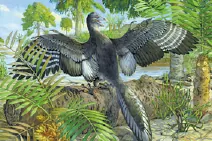
Unlocking the Secrets of Evolution: How a 150 Million-Year-Old Fossil Bridges Dinosaurs and Birds
2025-05-20
Author: Benjamin
A Groundbreaking Discovery in Paleontology
Exciting news has emerged from a remarkable collaboration between researchers in China and the United States, revealing new insights into the ancient evolutionary transition from dinosaurs to birds. This breakthrough comes courtesy of a brilliantly preserved specimen of Archaeopteryx, a pivotal species in understanding avian evolution.
The Archaeopteryx: A Feathered Link in Time
Recognized as the most primitive known bird dating back to the Late Jurassic period, around 150 million years ago, Archaeopteryx exhibits characteristics of both non-avian dinosaurs and modern birds. This newly analyzed fossil is reported to be the smallest and best-preserved specimen to date, discovered in limestone deposits near Solnhofen, Germany, in 2022.
"The specimen in Chicago is exceptionally intact, with only a single digit missing," stated Hu Han, a leading paleontologist from the Institute of Vertebrate Paleontology and Paleoanthropology.
3D Reconstruction: A Revolutionary Approach
Utilizing cutting-edge high-resolution CT scans, the research team successfully completed a 3D reconstruction of Archaeopteryx, highlighting intricate features of its skull that were previously inaccessible due to preservation limitations.
Hu emphasized the significance of this achievement, saying, "This breakthrough has unveiled previously unknown anatomical features and provided a crucial 3D model for future studies." The skull’s unique structure represents an evolutionary critical stage, illustrating the shift from the rigid skulls of nonavian theropods to the more flexible skulls found in modern birds.
A New Perspective on Lifestyle and Adaptation
Previous assumptions about Archaeopteryx's habits are now being challenged. The study identified preserved soft tissues, revealing toe pads reminiscent of today's ground-foraging birds, suggesting a lifestyle that included both arboreal and terrestrial activities. Hu remarked, "This indicates that it may have had a mixed lifestyle—spending some time in trees and some on the ground."
Revolutionary Flight Features Uncovered
In a fascinating twist, the research team discovered tertials—essential flight feathers that help streamline the wing and body for improved aerodynamics—in Archaeopteryx for the first time. Hu explained, "Tertials play a crucial role in maintaining wing surface efficiency and reducing air resistance, echoing the evolutionary adaptations necessary for flight."
Continuing the Journey of Discovery
As scientists build on these findings, they plan to delve deeper into quantitative studies of skull mechanics and wing aerodynamics to further explore the incredible evolutionary leap from dinosaurs to birds. Since the discovery of its first fossil in 1861, right after Charles Darwin introduced his theory of evolution, Archaeopteryx has remained a vital piece of the evolutionary puzzle.
This new research not only enhances our understanding of Archaeopteryx but also opens avenues to track the intricate changes that paved the way for bird flight. Stay tuned as these dedicated researchers continue their quest to reveal the mysteries of our planet's prehistoric past!









 Brasil (PT)
Brasil (PT)
 Canada (EN)
Canada (EN)
 Chile (ES)
Chile (ES)
 Česko (CS)
Česko (CS)
 대한민국 (KO)
대한민국 (KO)
 España (ES)
España (ES)
 France (FR)
France (FR)
 Hong Kong (EN)
Hong Kong (EN)
 Italia (IT)
Italia (IT)
 日本 (JA)
日本 (JA)
 Magyarország (HU)
Magyarország (HU)
 Norge (NO)
Norge (NO)
 Polska (PL)
Polska (PL)
 Schweiz (DE)
Schweiz (DE)
 Singapore (EN)
Singapore (EN)
 Sverige (SV)
Sverige (SV)
 Suomi (FI)
Suomi (FI)
 Türkiye (TR)
Türkiye (TR)
 الإمارات العربية المتحدة (AR)
الإمارات العربية المتحدة (AR)